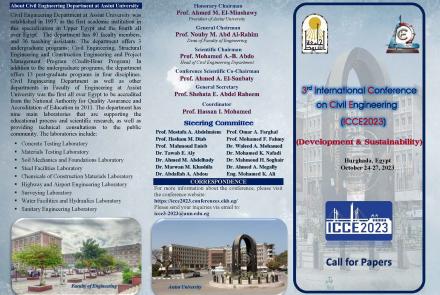Energy Management and Renewable Energy Utilization in Buildings:Csse Study Administrative Building of Assiut University
تحليل وتصميم نظام تغذية كهربائية لمستشفى
Design of electrical distribution system and utilizing renewable energy sources to feed educational building
تحسين كفاءة الطاقة فى المبانى الحكومية
Real Field testing and developing of VAWT for pumping water from underground Well
Effect of Warm Mix Asphalt (WMA) Antistripping Agent on Performance ofWaste Engine Oil-Rejuvenated Asphalt Binders and Mixtures
Evaluating the performance of rejuvenated asphalt mixes is crucial for pavement design and construction, as using a rejuvenator not only boosts recycling and contributes to positive effects on the environment but also increases the sensitivity to rutting and moisture. This study was executed to evaluate the effect of a warm mix asphalt (WMA) antistripping agent, namely nano-ZycoTherm, on the moisture-induced damage and rutting potential of asphalt mixtures containing 30% and 60% aged (RAP) binder and rejuvenated with 12% waste engine oil (WEO). For this purpose, the rutting resistance of asphalt mixes in wet and dry conditions was examined utilizing a loaded wheel tracker. In addition, the impacts of moisture on the performance of the mixtures were evaluated using different experiments, such as modified Lottman (AASHTO T283), resilient modulus, dynamic creep, aggregate coating and wheel tracking tests. Fourier transform infrared (FTIR) spectroscopy and thermogravimetric (TG) analysis were performed to identify the functional groups, which would be significant in terms of moisture damage, and to assess the thermal stability of binder samples, respectively. The results revealed that the rejuvenation of aged binder with WEO increases the moisture susceptibility of the mixtures; however, the addition of ZycoTherm was found to enhance the moisture resistance of WEO-rejuvenated mixtures. Furthermore, the results indicated that the WEO-rejuvenated mixtures modified with ZycoTherm exhibited a better rutting resistance in a wet condition compared to that of WEO-rejuvenated and conventional HMA mixtures. However, the rejuvenated mixtures modified with ZycoTherm showed poorer rutting performance in a dry condition. In summary, the adoption of the WMA antistripping agent, RAP binder and WEO rejuvenation techniques demonstrated satisfactory outcomes in terms of rutting resistance and moisture susceptibility, and also, these techniques are much less expensive to implement.
PLC Applications in Controlling a Train Drived by a Three- phase induction motor
The rule of the front and behind top edges of weirs on their hydraulic performance and working efficiency
The geometry of weirs is a prime factor influencing hydraulic performance and accuracy. One of the geometric components of weirs, is the situation of its top corners, are they sharp or rounded, and what is the most suitable radius of such rounding curves? The present study was conducted to examine the effect of using five different radius of curvature for both the upstream and downstream top corners of a clear over-fall weir on its hydraulic performance and accuracy. Eleven models of wooden weirs were shaped and prepared with five different
values of rounding curvature. The prepared weir models were located in a laboratory tilting flume of 13.50 m length, 0.30 m width, and 0.30 m depth. The study was carried out in the Irrigation and Hydraulic Laboratory of the Civil Department, Faculty of Engineering, Assiut University, Egypt. A discharge ranging from 2.0 to 22.0 dm3 s–1 was used, and through 66 experimental runs, all the necessary hydraulic parameters were measured, and recorded. The obtained data were tabulated, analyzed, plotted, and technically discussed. The main results
and obtained conclusions proved that when the front weir top edge is curved the discharge coefficient increases up to 8%. Also, when both front, and behind weir top edges are curved the discharge coefficient increases up to 14%. At the same time the discharge coefficient has a maximum value when the radius of curvature in upstream and downstream top corners equals 20% of the height of the weir.


